Mental health and wellbeing among adolescents in Scotland: profile and trends
Mental Health and Wellbeing among Adolescents in Scotland looks at trends and key associations for the mental health of boys and girls aged 13 and 15. The report found that friendships and a positive experience of school are the two things most closely aligned with mental wellbeing. Other factors include playing sport at least once a week, belonging to a club, expecting to go to university and reading books. Deprivation and poorer physical health both correlate with lower mental wellbeing.
This document is part of a collection
4 Equalities and mental health and wellbeing in 2013
Key Findings
- Girls were more likely than boys to have borderline or abnormal scores for the overall SDQ scale, emotional problems and hyperactivity. However, boys were more likely than girls to have problems with conduct, peers or pro-social behaviour.
- Emotional and behavioural problems appeared to increase, while mental health and wellbeing decreased as pupils moved further into adolescence.
- Pupils who reported that they had a limiting illness or disability tended to suffer from poorer mental health and wellbeing as well as poorer physical health.
- Pupils who had a mixed or multiple ethnicity were more likely to suffer from poor mental health and wellbeing than those from other ethnicities.
- Higher levels of deprivation were correlated with poorer mental health and wellbeing. Both Scottish Index of Multiple Deprivation (SIMD) and perceived family affluence, showed a relationship with mental health and wellbeing. However, perceived family affluence had a stronger association than the geography based measure of deprivation (SIMD).
Existing findings from other sources
- Rates of mental health problems among children increase as they reach adolescence. Disorders affect 10% of boys aged 5-10, rising to 13% of boys aged 11-15, and 6% of girls aged 5-10, rising to 10% of girls aged 11-15. (6)
- Prevalence of depressed mood or anxiety was 2.5 times higher among young people aged 10 to 15 years with low socioeconomic status than among youths with a higher socioeconomic status (11).
- The parents of children with an emotional disorder were more than four times as likely as other parents to say that their child's general health was fair or bad (23 per cent compared with 5 per cent) (6).
- In terms of young people aged 5-16 years, 9% of children from Black backgrounds, 8% of children from Pakistani and Bangladeshi backgrounds, and 3% of children from Indian backgrounds had a mental disorder compared to 10% of children from White backgrounds (12).
Equalities questions in SALSUS
4.1 The equalities variables considered in this report are sex, age, illness/disability, ethnicity and deprivation (SIMD and perceived family affluence).
Equalities variables in SALSUS 2013
4.2 Figure 4.1 shows the breakdown of the sample for each of the equalities variables included in the SALSUS survey.
Figure 4.1 - Pupil breakdown of equalities variables, 2013
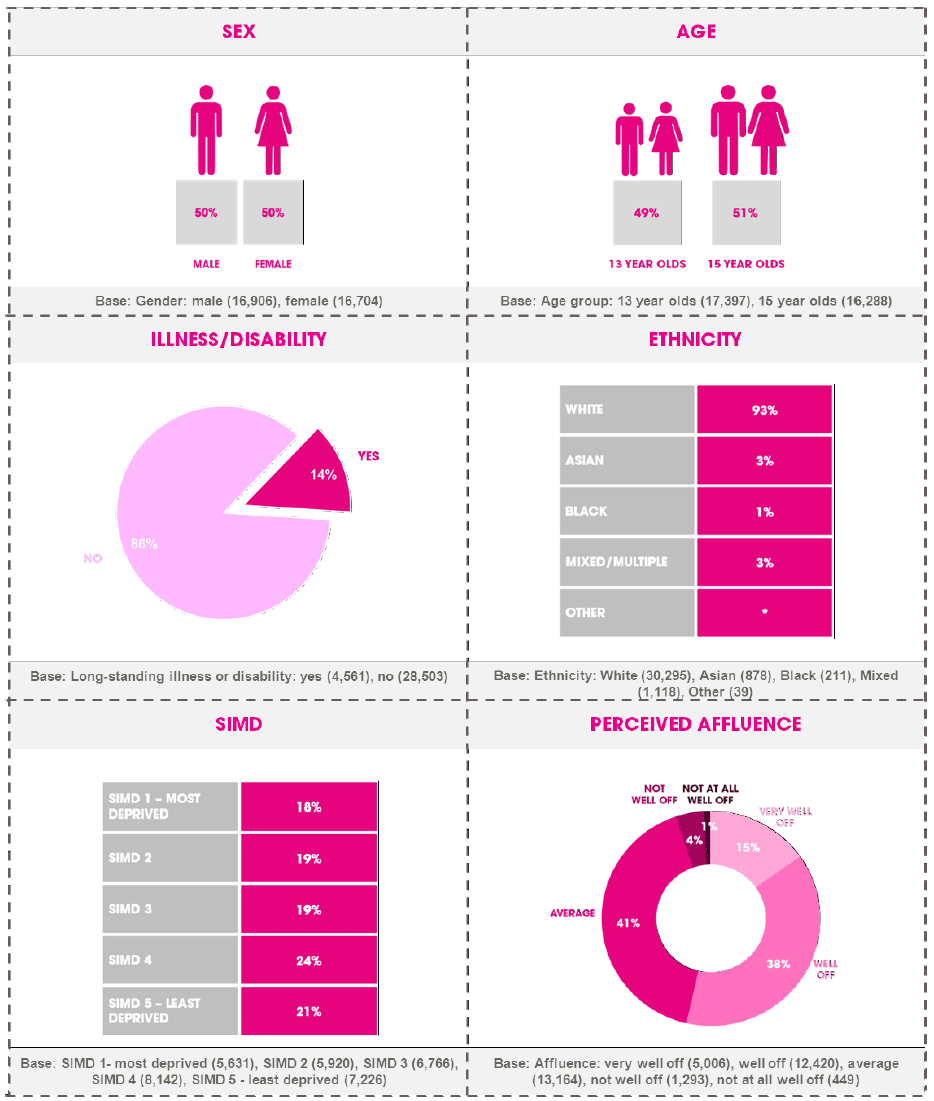
4.3 It should be borne in mind that using SIMD means that we are looking at an area based measure to identify deprivation in individuals. Many people who are materially disadvantaged as individuals live in areas that are not particularly deprived in terms of SIMD; equally, many people living in deprived areas (as identified by SIMD) may not be particularly disadvantaged. For that reason, it is also important to look at family level measures of deprivation (perceived affluence).
4.4 In 2013, 37% of pupils did not supply a postcode - either because they did not know it or did not want to write it in. Missing postcodes were imputed by sorting the data by class within schools. If a postcode was missing, the postcode of another randomly selected pupil from the same class was used.
4.5 The figures suggest that those who did not provide a postcode were more likely to be those living in areas of deprivation (see Table 4.1). Imputing the postcodes improved this but those living in the most deprived areas were still underrepresented. The data was weighted to account for these differences.
Table 4.1 SALSUS 2013 - SIMD by postcode imputation[8]
| SIMD before postcode imputation and checking |
SIMD after postcode imputation and checking |
SIMD after weighting applied |
Population estimates for 13 and 15 year olds 2013[9] |
|
|---|---|---|---|---|
| SIMD 1 - most deprived |
16% |
17% |
18% |
20% |
| SIMD 2 |
17% |
18% |
19% |
18% |
| SIMD 3 |
20% |
20% |
19% |
19% |
| SIMD 4 |
24% |
24% |
24% |
21% |
| SIMD 5 - least deprived |
22% |
21% |
21% |
21% |
| Bases |
33,685 |
33,685 |
33,685 |
115,915 |
Equalities variables by mental health and wellbeing
4.6 Overall, girls were more likely than boys to have a borderline or abnormal SDQ score. While girls were more likely to have borderline or abnormal scores for emotional problems and hyper activity, boys were more likely to have borderline or abnormal scores on the conduct, hyperactivity and pro-social scales (Figure 4.2).
Figure 4.2 SDQ scales, including overall score, by sex (% borderline or abnormal score) (2013)
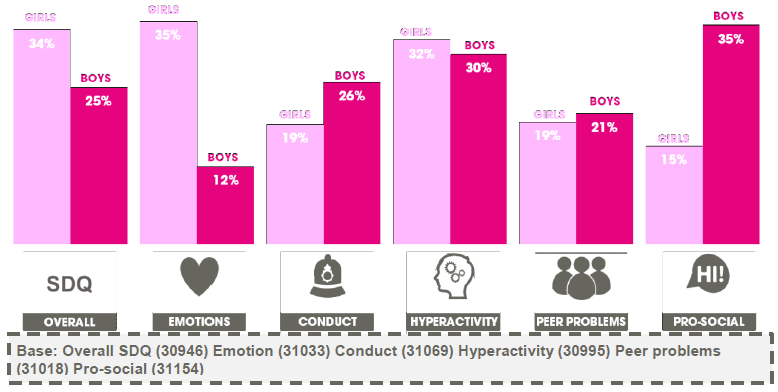
4.7 Boys also had a higher average WEMWBS score than girls indicating higher levels of mental wellbeing (Table 4.2).
Table 4.2 Average WEMWBS score by sex
| Sex |
Average WEMWBS score |
Base |
|---|---|---|
| Male |
50.7 |
14976 |
| Female |
46.8 |
15017 |
4.8 A higher proportion of 15 year olds had borderline or abnormal scores on the overall SDQ, emotions, hyperactivity and pro-social scales than 13 year olds. There was no difference between the year groups on the conduct and peer problems scales (Figure 4.3).
Figure 4.3 SDQ scales, including overall score, by age (% borderline or abnormal score) (2013)
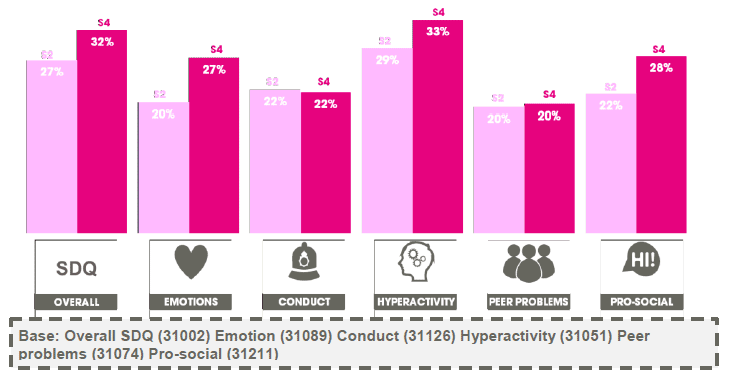
4.9 13 year olds had a higher average WEMWBS score than 15 year olds suggesting that they are more likely to have better mental wellbeing (Table 4.3).
Table 4.3 Average WEMWBS score by age
| Age |
Average WEMWBS score |
Base |
|---|---|---|
| S2 |
50.0 |
15107 |
| S4 |
47.6 |
14936 |
4.10 Having a limiting illness or disability was associated with higher borderline or abnormal scores on all of the SDQ scales, with the exception of the pro-social scale, but including the overall difficulties score (Figure 4.4).
Figure 4.4 SDQ scales, including overall score, by whether have limiting illness or disability (% borderline or abnormal score) (2013)
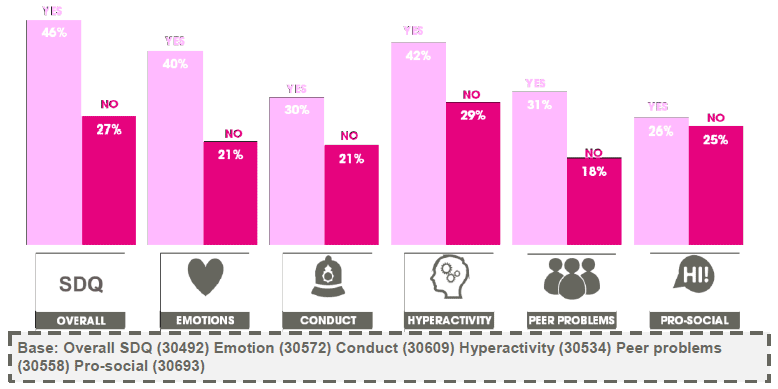
4.11 Those with a limiting illness or disability had lower levels of mental health and wellbeing than those who did not (Table 4.4).
Table 4.4 Average WEMWBS score by illness or disability
| Limiting illness or disability |
Average WEMWBS score |
Base |
|---|---|---|
| Yes |
45.0 |
4112 |
| No |
49.3 |
25563 |
4.12 Pupils who had a mixed or multiple ethnicity were most likely to have a borderline or abnormal score on every SDQ scale except for hyperactivity. Asian pupils were least likely to have emotional and behavioural difficulties (Figure 4.5).
Figure 4.5 SDQ scores by ethnicity (% borderline or abnormal score) (2013)
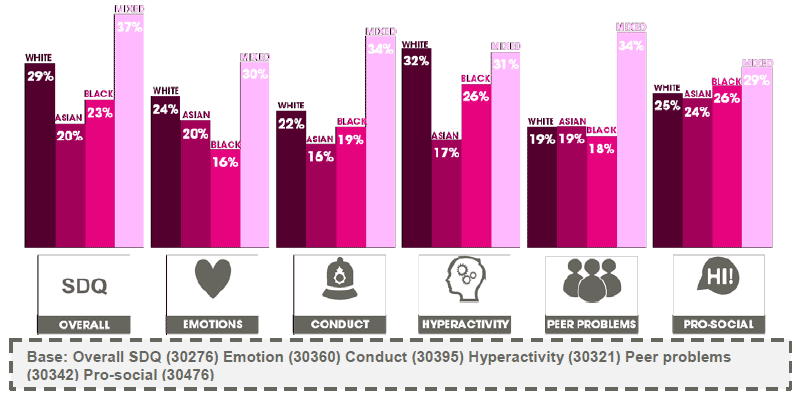
4.13 In line with the SDQ figures, it was pupils with a mixed or multiple ethnicity who had the lowest average mental health and wellbeing score (Table 4.5).
Table 4.5 Average WEMWBS score by ethnicity
| Ethnicity |
Average WEMWBS score |
Base |
|---|---|---|
| White |
48.8 |
27293 |
| Asian |
49.3 |
777 |
| Black |
49.7 |
177 |
| Mixed |
47.1 |
945 |
4.14 Pupils who lived in the most deprived areas were most likely to have a borderline or abnormal score on every SDQ measure except emotional problems which did not show such a clear cut relationship with SIMD (Figure 4.6).
Figure 4.6 SDQ scales by SIMD (% borderline or abnormal score) (2013)
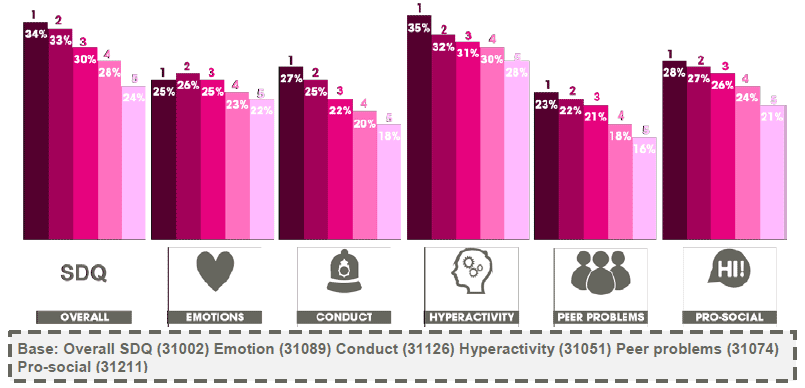
4.15 Average mental wellbeing increased as deprivation level decreased. However, the relationship was not that strong (Table 4.6).
Table 4.6 Average WEMWBS score by SIMD
| SIMD |
Average WEMWBS score |
Base |
|---|---|---|
| 1 - Most deprived quintile |
48.0 |
4789 |
| 2 |
48.5 |
5264 |
| 3 |
48.2 |
6101 |
| 4 |
49.2 |
7312 |
| 5 - Least deprived quintile |
49.5 |
6577 |
4.16 Perceived family affluence had a stronger relationship with emotional and behavioural difficulties than SIMD. Pupils who thought that their family was not well off were more likely to have borderline or abnormal scores on each of the individual SDQ measures with the exception of the pro-social scale (Figure 4.7).
Figure 4.7 SDQ scales by perceived affluence (% borderline or abnormal score) (2013)
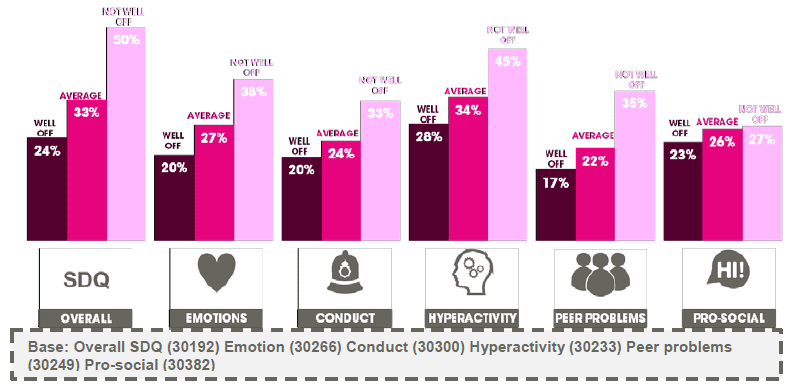
4.17 Pupils who thought that their family was either very or quite well off had higher levels of mental health and wellbeing than those who thought that their family was not or not at all well off (Table 4.7).
Table 4.7 Average WEMWBS score by perceived affluence
| Perceived affluence |
Average WEMWBS score |
Base |
|---|---|---|
| Very well off |
51.5 |
4395 |
| Quite well off |
50.1 |
11322 |
| Average |
47.3 |
11956 |
| Not well off |
43.9 |
1161 |
| Not at all well off |
42.3 |
377 |
Contact
Email: Iain MacAllister
There is a problem
Thanks for your feedback